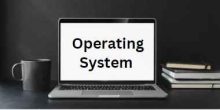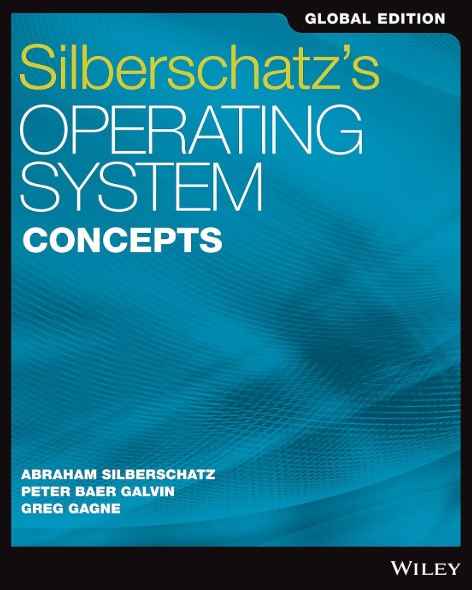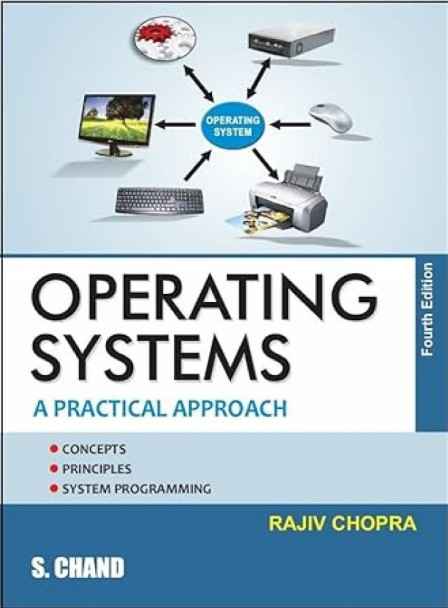Unit 1
Operating system and functions, Classification of Operating systems- Batch, Interactive, Time-sharing, Real Time System, Multiprocessor Systems, Multiuser Systems, Multi-process Systems, Multithreaded Systems, Operating System Structure: Layered structure, System Components, Operating System services, Re-entrant Kernels, Monolithic and Microkernel Systems.
Q61 – Supervisor state is
never used
entered by programs when they enter the processor
required to perform any I/O
only allowed to the operating system
Ans – (4)
Explanation – The supervisor mode, or privileged mode, is a mode of operation in which the operating system can execute instructions that are not permitted in the user mode (i.e., user space). Operating only in this mode, it gives the OS complete control of hardware and system resources like I/O operations, memory management, and process scheduling.
Q62 – Which of the following systems software does the job of merging the records from two files into one?
Security software
Utility program
Networking software
Documentation system
Ans – (2)
Explanation – A utility program is an application of system software to perform specific tasks that help manage and maintain the computer resources. Some of the other tasks may involve work like file management, such as merging records from two files into one, sorting files, backing up files, running diagnostics on hardware and software, or basically other basic housekeeping functions for monitoring proper operation of given devices.
Q63 – Addressing structure
defines the fundamental method of determining effective operand addresses
are variations in the use of fundamental addressing structures, or some associated actions which are related to addressing.
performs indicated operations on two fast registers of the machine and leave the result in one of the registers.
all of the above
Ans – (1)
Explanation – Addressing structure refers to the ways and means which the processor implements to compute the address of an operand in memory. This includes specifying the method of calculation of the effective address (the actual address of the operand within memory) for the purpose of data access.
Q64 – A system program that combines the separately compiled modules of a program into a form suitable for execution
assembler
linking loader
cross compiler
load and go
Ans – (2)
Explanation –
A linking loader is a system program, which relates to the combination of separately compiled modules of a program and linking them into a form that is suitable for execution. The linking loader links together the object-code-modules, resolves the addresses of locations, and prepares the final executable file.
Assembler – An assembler changes assembly language code into machine code without linking separate modules.
Cross compiler – A cross compiler translates code from one programming language into machine code for another platform and is not specifically for linking modules.
Load and go – This is a type of loader that loads the program into memory and executes it immediately, but this is not a form of linking separate modules.
Q65 – Which of the following is not a part of operating system?
supervisor
performance monitor
job-control program
input/output control program
Ans – (2)
Explanation – A performance monitor is not normally regarded as a part of the operating system itself. It is an object or utility that is typically used to monitor the system and analyze its performance but is not in any way a component of the operating system.
Q66 – The operating system creates _____ from the physical computer.
Virtual space
Virtual computers
Virtual device
None of the above
Ans – (1)
Explanation – When the operating system manages the hardware resources, it creates a virtual space to facilitate easy management of the memory and the resources. For instance, with virtual memory, applications can address memory space in excess of what is physically present by exchanging data between the much smaller size of RAM and the much larger size of storage. The operating system creates a virtual environment in which applications can function as if there were distinct resources dedicated to their own running.
Virtual space: A term for virtual memory-space where physical memory is made up of bigger logical address space.
Why Virtual computers is incorrect
A virtual computer or virtual machine is more of a concept that refers to virtualization, wherein an OS or hypervisor provides isolated environments that seem like multiple independent computers. These virtual machines are instigated on top of a physical system with their management by a hypervisor and not by a traditional OS directly.
Q67 –Which of the following are the functions of operating system?
i) recovering from errors
ii) facilitating input/output
iii) facilitating parallel operation
iv) sharing hardware among users
v) implementing user interface
i, ii, ii, and v only
i, ii, iii, and iv only
ii, iii, iv and v only
All i, ii, iii, iv and v
Ans – (4)
Explanation – The functions of an operating system include all of the following:
- Recovering from errors
The OS includes mechanisms which enable it to detect errors and recover from them so that everything works as intended. - Facilitating input/output
OS management of the input/output systems dictates how data gets to the input and finally to the output phase. - Facilitating parallel operation
On modern operating systems, multitasking and parallel operation deal with several tasks running side by side on several processors or cores. - Sharing hardware among users
The OS system, which is made possible for sharing among users, should allow for the control and management of shared hardware resources among more than one user and processes. - Implementing user interface
The OS provides some sort of an interface, command line interface (CLI), graphical user interface (GUI), and so on for the user to interact with the system.
Q68 – ………… is a special type of programming language used to provide instructions to the monitor simple batch processing schema.
Job control language (JCL)
Processing control language (PCL)
Batch control language (BCL)
Monitor control language (MCL)
Ans – (1)
Explanation – Job Control Language (JCL) is a special programming language used for instructing the monitor in a very simple batch processing schema. JCL is used to define the sets of tasks that the OS should perform, including loading programs, allocating resources (memory and I/O devices), and scheduling jobs in a batch processing environment.
Q69 – With ……………. only one process can execute at a time; meanwhile all other process is waiting for the processer. With ………….. more than one process can be running simultaneously each on a different processer.
Multiprocessing, Multiprogramming
Multiprogramming, Uniprocessing
Multiprogramming, Multiprocessing
Uniprogramming, Multiprocessing
Ans – (4)
Explanation – In a uniprogramming system, only one process can run at a time, and the other processes must wait until the currently running process completes before being allowed access to the processor. Such a system simply cannot support concurrent execution.
A multiprocessing system is one in which more than one process can execute concurrently, with each process being executed in an individual processor or CPU. Performance in multiprocessing systems can be improved with parallel execution of processors.
Q70 – A ……………….. architecture assigns only a few essential functions to the kernel, including address spaces, Inter process communication (IPC) and basic scheduling.
Monolithic kernel
Micro kernel
Macro kernel
Mini kernel
Ans – (2)
Explanation – A microkernel architecture is designed to minimally size the kernel to maximize its efficiency. It assigns to the kernel the most limited functions necessary.
Address spaces: Management of memory and translation of address space.
Interprocess communication (IPC): Mechanism for communication between processes.
Basic scheduling: Control of sequence of execution of processes.
Other functions, such as device drivers, filesystems, and networking, are performed in the user space and outside the kernel. This modularization builds up security, reliability, and flexibility.
Q71 – Multiprogramming was made possible by
input/output units that operate independently of the CPU
operating system
both a and b
None of the above
Ans – (3)
Explanation – Multiprogramming is simply an operating system’s ability to run multiple programs at an instance on a single CPU by switching quickly between them. Perfectly possible because of
Input/output units that operate independent of the CPU
I/O devices that can operate independently from the CPU free the CPU to run other processes while waiting for the input/output operations to complete. This enhances the efficiency of multiprogramming.
The operating system
The operating system controls the process scheduling and allocation of CPU time between different programs to assure effective sharing of the CPU. It coordinates and manages execution among concurrent running programs.
Q72 – The primary purpose of an operating system is:
To make the most efficient use of the computer hardware
To allow people to use the computer
To keep systems programmers employed
To make computers easier to use
Ans – (1)
Explanation – Within this environment, the OS will be responsible for making sure that other processes can work one way or another, allowing the use of all hardware devices in the workstations in an efficient manner. CPU, memory, storage, and input/output devices are used effectively through multitasking, sharing resources, and performance management.
Q73 – Which of the following Operating System does not implement multitasking truly?
Windows 98
Windows NT
Windows XP
MS DOS
Ans – (4)
Explanation – MS-DOS (Microsoft Disk Operating System) does not support true multitasking. It is a single-tasking operating system, meaning that it can load only one program at a time. If you want to run several applications on the PC, you have to close one before running another.
Q74 – Which is built directly on the hardware?
Computer Environment
Application Software
Operating System
Database System
Ans – (3)
Explanation – The Operating System is built on the very hardware of the computers. It is the software that manages the hardware resources of the computer and provides necessary services for the execution of other types of software (including application software). The operating system works directly with hardware components like the CPU, memory, storage, and input/output devices to control and manage them.
Q75 – Which is the first program run on a computer when the computer boots up?
System software
Operating system
System operations
Application software
Ans – (2)
Explanation – As the computer starts to boot, the first program to be executed is none other than the operating system. This is due to the fact that the operating system initializes the hardware, loads system resources, and creates environments for all other computer programs operating on it.
Q76 – ………… is a large kernel, including scheduling file system, networking, device drivers, memory management and more.
Monolithic kernel
Micro kernel
Macro kernel
Mini kernel
Ans – (1)
Explanation – A monolithic kernel defines an operating system in which all critical functions are performed.
File system network
Device Drivers
Memory Management
Networking
All these components are said to run in the same address space. The speed was surely within reach, but there were no modules available here as in the rest of the types.
Q77 – The first batch operating system was developed in the …………….. by General Motors for use on an IBM 701.
mid 1940’s
mid 1950’s
mid 1960’s
mid 1970’s
Ans – (2)
Explanation – The first batch operating system was created in the mid-1950s by General Motors for the IBM 701. This system allowed programs to be batched-sent for processing. This was a big advancement over earlier manual methods of programming.
Q78 – Which of the following loader is executed when a system is first turned on or restarted
Boot loader
Compile and Go loader
Bootstrap loader
Relating loader
Ans – (3)
Explanation – A bootstrap loader is a loader executed when a computer is powered on or reset. It sets up the hardware and loads the core kernel of the operating system into the volatile memory. The process is known generally as bootstrapping or booting.
Boot loader – is a general term for the program that loads the operating system. It refers to an initial loader that runs when the computer is turned on.
Compile and Go loader – Loosely speaking, this type of loader compiles and then runs programs immediately. It would not be directly related to loading in the boot sense.
The loader probably missed referring to “Relocating loader” which does address changes during program loading rather than bootstrapping.
Q79 – Your system response time is very poor. What may be the reason?
Processor is busy
I/O rates may be high
High paging rates
All of the above
Ans – (4)
Explanation – Processor is busy – If the CPU is used up by heavy and long-running processes, the response to the other tasks gets delayed.
I/O rates may be high – High input/output rates (e.g., reading/writing to disk) can slow the system down since those operations are generally much slower than CPU operations.
Higher Paging rates – Frequent swapping of data between RAM and the disk through insufficient memory may cause a massive performance bottleneck termed “thrashing”.
Q80 – The address generated by the CPU is referred to as:
physical address
logical address
physical as well as logical address.
None of the above
Ans – (2)
Explanation – The address specified by the CPU during the operation of a program is the logical address, and it is specified by the program. It needs to be translated into a physical address by the memory management unit or MMU before physical memory can be accessed.
Physical address is the one which is the actual address in the physical memory (RAM). The logical address is translated utilizing some processes like paging or segmentation into physical address with the aid of the MMU.




